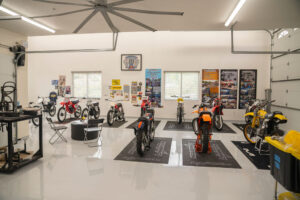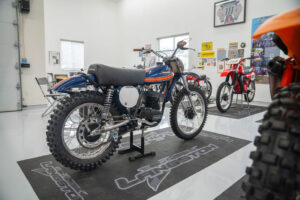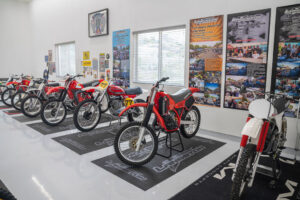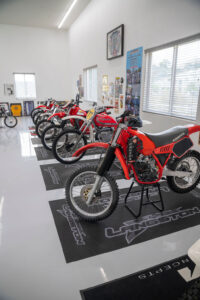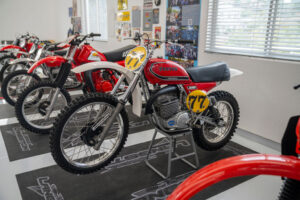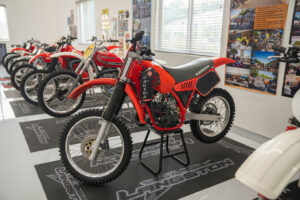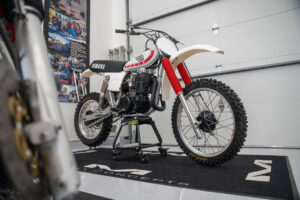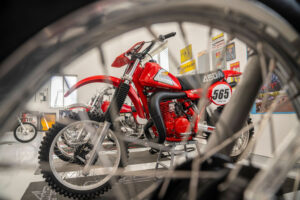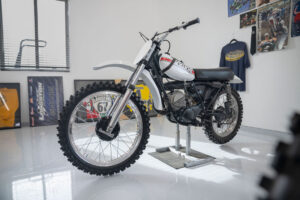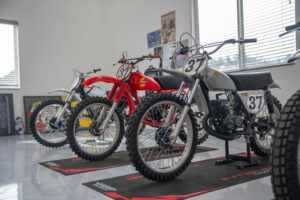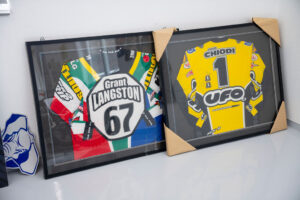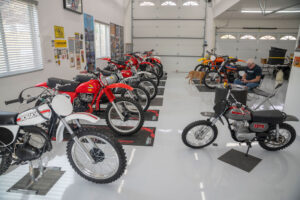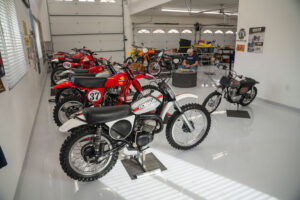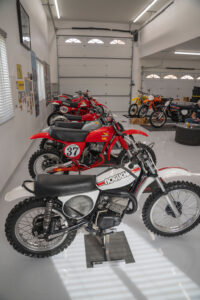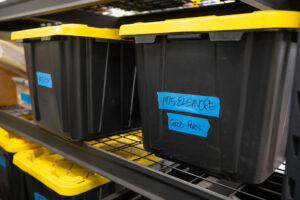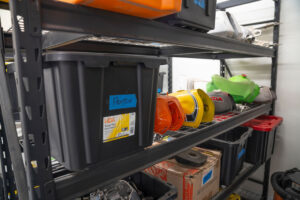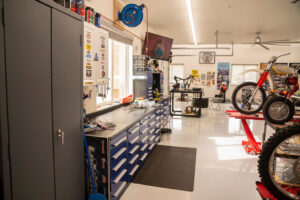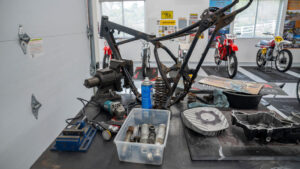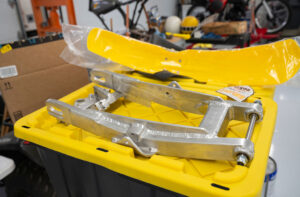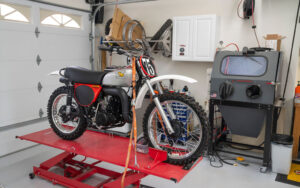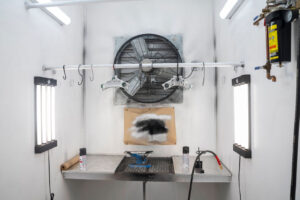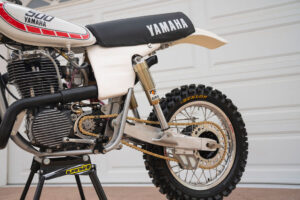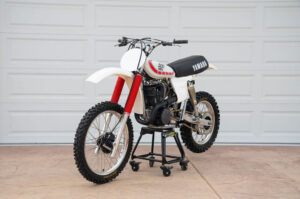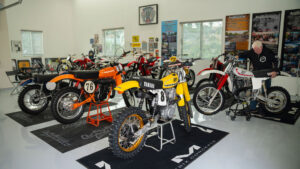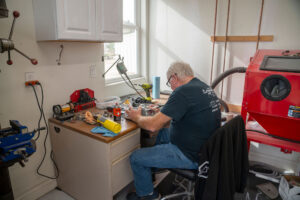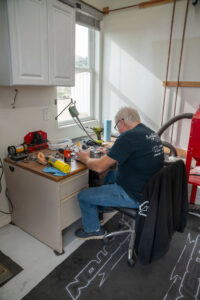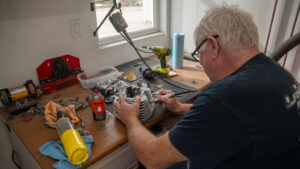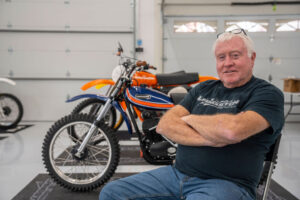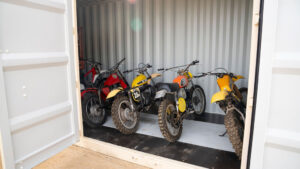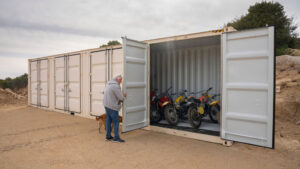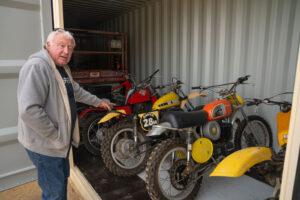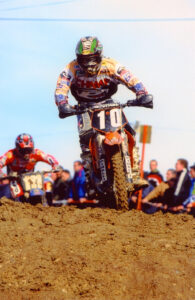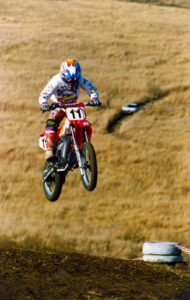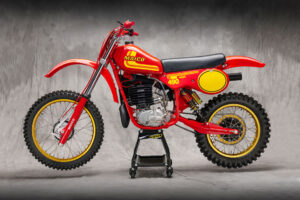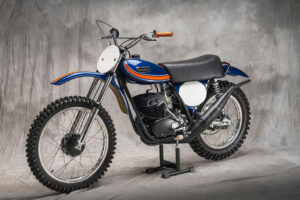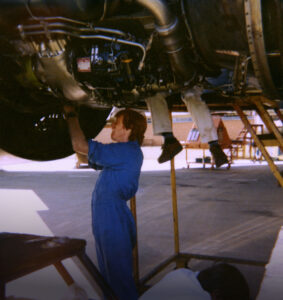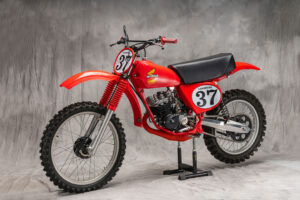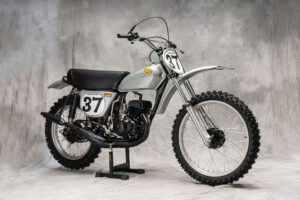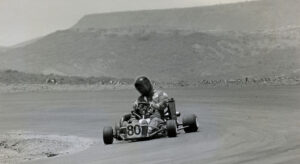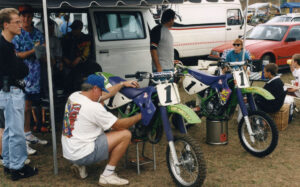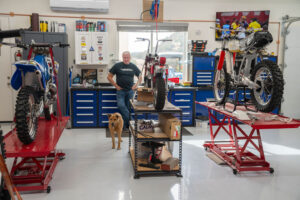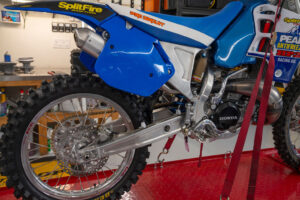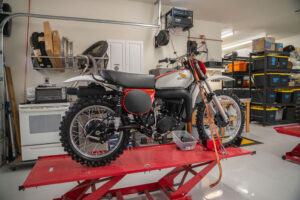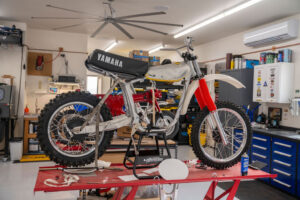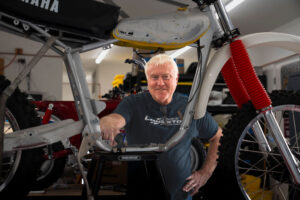Gerald Langston
by David Dewhurst
Restoring a Honda Elsinore motocross bike should be a pretty straightforward job when you’ve been trained to maintain 747 passenger jets. Well, it would be straightforward if you were not a perfectionist. When I ask Gerald Langston if, maybe, he’s a little OCD, his wife Amanda nods her head behind his back. Gerald likes to say he’s just meticulous. Whatever the reason, Langston’s motocross restorations are works of art, and, more importantly, he does virtually every bit of the restoration work himself.
Gerald only started his beautiful restorations quite recently because, to put it mildly, he’s had many other things going on in the last fifty years. After finishing his national service in his native South Africa, the Durban native worked as a maintenance technician for South African Airways, maintaining their fleet of Boeing 747s. On weekends, he’d be racing a used 1974 125cc Honda Elsinore at the local tracks. He progressed quickly through the ranks, and it wasn’t long before he had a South African ex-works 1976 125 Honda. “Motocross was huge back then in South Africa,” says Langston, “and I made it as far as #37 in the National A class.” Then, a friend introduced him to go-karts, and his life took an unexpected turn.
Racing karts brought him into contact with an extremely wealthy property developer who dreamed of building a giant racing facility with a 2.6-mile road course capable of hosting Formula One races. Gerald Langston helped move this bold plan towards reality. Bulldozers moved mountains of dirt at the former Idube (Zebra) Ranch outside Durban, and the iDube International Raceway was moving forward quickly until the fateful day when the money man landed at the half-finished track in his helicopter. The investor stepped out of his Bell Jet Ranger with a bag full of cash for his employees’ wages and was mowed down in a barrage of gunfire.
Dreams of an F1 race died that day along with the investor, but the track lived on as a slightly more modest facility that would host national go-kart championship races and dirt oval events. More importantly for Langston’s convoluted future, iDube International would also sprout a motocross track.
While Gerald was still blasting around the asphalt in his go-kart, his five-year-old son got his first taste of racing on the motocross track. Five-and-a-half-year-old Grant showed early promise, and the daily practice on the huge track allowed him to hone his skills quickly. Gerald even allowed Grant to ride against the adults; the youngster was winning everything before long. Aboard a KX80 Kawasaki, Grant won all but one race in 1996, attracting the attention of the South African Kawasaki importer. With Dad as his riding coach and mechanic, young Grant was virtually unstoppable. He was so fast and dominant that at age twelve, the South African Motorcycle Federation picked Grant as one of their team members in the annual Coupe de l’Avenir, a Motocross des Nations for under-21 riders.
Langston’s performance on a borrowed Kawasaki was enough to dazzle former world champion Harry Everts, who wanted Grant to join his privateer Kawasaki team in the 125cc World Championships. Grant was only fifteen, but dad and son decided to roll the dice and move to Belgium. It was a massive decision with virtually no money and definitely no guarantees. “We were poor, and we were outcasts,” remembers Grant his early days in Belgium. The almost unbeaten South African also had to come to terms with suddenly being an also-ran. Grant didn’t even qualify to race in the early rounds in Spain and England, but by the penultimate round in France, Grant managed an eighth place.
It was a reality check for Grant and Gerald. As they sat in their car on a cold and damp day in Belgium, wondering if the dream might have ended before it really began, they received a call from Kees Van Der Ven offering a place on a 125cc KTM for the 1999 Grand Prix season. There was no multi-million Euro contract or a Ferrari thrown in with the deal, but the Langstons finally had their feet on the lower rungs of the GP ladder.
With more experience and a good race bike beneath him, Grant was soon scoring points. Grant finally stormed to a two-moto victory against eventual World Champion Alessio Chiodi at the twelfth round in Germany. He finished the season in tenth place, but more importantly, he finished on a hugely positive high.
With Gerald still helping as Grant’s riding coach and keeper of the faith, Grant received even better news from KTM factory team manager Kurt Nicoll. Impressed by Grant’s speed, the Englishman persuaded the factory to give the young South African their full support for the 2000 season. It was the big step that the Langstons had worked so long and hard for, and they didn’t disappoint.
From the first race in Bellpuig, Spain, Grant showed immense potential against American contender Mike Brown and Englishman James Dobb. The break-out season became a rocket ship ride with twelve moto wins and six second-place finishes. People were really starting to take notice, and early in the season, while Gerald and Grant were making the long drive across Europe to the Croatian GP, Team Langston had a big surprise. “Cell phones were kind of new,” recalls Grant. “We were driving to the race, and I got a call from the US. It was Mitch Payton telling me he had been watching my results and was wondering if I wanted to race a Kawasaki for him in America.”
Mitch Payton had a good eye because Grant’s GP season went better than even he expected. After sixteen rounds the young South African had 25 podium finishes and twelve moto wins. It was a blowout championship victory that had everyone talking. Mitch Payton was still keen to sign the new World Champion, but Kurt Nicoll was determined to keep their new champion riding a factory KTM no matter what it took.
Knowing Grant was interested in moving to America, KTM offered a factory-backed ride in the 125cc National Championship, and the Langstons jumped at the offer. It was yet another massive move even farther from their native South Africa, but the chance for Grant to make his mark in the biggest bike market in the world was hard to turn down.
Grant quickly showed that his World title was no fluke as he battled America’s best in the outdoor 125cc Nationals. By season’s end, only Mike Brown could outpace Langston, and the World Champion missed adding the US title in a 458 to 444 points battle. The South African also managed a 4th-place finish in the 125cc West Supercross Championship to round out an impressive first season in America.
The following season turned into a massive disappointment for Grant as a knee injury at Hangtown kept him out of action for most of the season. Things in Team Langston were getting tough in other ways in 2002. Grant enjoyed full factory backing with engine builders and suspension technicians caring for everything mechanical. Gerald was suddenly sidelined from the job he’d enjoyed for almost fifteen years. “He’d been my mentor, my guardian, and my mechanic,” admits Grant. “He even took me training and could run faster than me.” It had been a great team effort, but father and son admit it was a tough time for both of them.
Back to full strength in 2003, Grant started the season on a 250 KTM and admits the bike was not very good. His lowly 34th-place finish reflects that harsh reality. But switching back to the 125cc KTM, he again showed the speed that made him a multi-time champion. Against Ryan Hughes and up-and-coming James Stewart, Langston took his factory KTM to championship victory. 
Langston’s career went on a roller-coaster ride as he switched to Kawasaki and then Yamaha. 2004 was a year he’d probably want to forget, but he came back in 2005 with a 4th-place finish in the 125cc outdoor championship and an overall win in the 125cc Supercross East series. He followed that up with another 125cc Supercross West championship in 2006.
Things turned around for Langston with a switch to factory Yamaha machinery in 2007. In a tight season-long battle with Mike Alessi, Grant pulled out a resounding championship victory that would be his last. Still aboard Yamaha for the 2008 season, things were not clicking for the champion. Frustrated and unable to get back to his dominant ways, Grant sought help from a doctor and was finally diagnosed with cancer in one eye. With only limited vision, the champion could not judge the distances so critical to a motocrosser.
Doctors eventually managed to put Grant’s cancer into remission, but not before he lost sight in that eye. After sitting out the entire 2009 season, Grant tried returning to racing in 2010, but the visual impairment was too much for even a motocross champion to overcome. It was time to retire, but Grant could not accept his fate. It took a major family intervention to finally get the champion to hang up his boots.
It was a double retirement, really, because mentor, guardian, and father Gerald was suddenly without the weekly grind of motocross races that had been a major part of his life since Grant was just five years old. He had Langston Motorsports in Perris, California, to run, but he needed something else to fill the void of professional racing.
Like so many older racers, Gerald found great satisfaction in restoring some of the old bikes of his early racing days in South Africa. His first restoration was a replica of the 1974 Honda Elsinore 125 that started his passion for motorcycles. He soon moved on to a 1977 Honda Elsinore 125 FMF bike that rekindled memories of his ex-factory Honda. From there, the list gets more diverse with a 1981 490 Mega Maico followed by a couple of 1992 Kawasaki KX500s and a 1981 Honda CR450. There was also a brief Spanish period with a 1974 Ossa Phantom backed up by a 1972 Bultaco Sherpa 200.
Father and son finally rekindled their family bonding with a 1973 Honda XR75 rebuild. This wasn’t Gerald’s favorite bike, but it did lead to his ongoing passion: Yamaha’s 1978 HL540. Like all of his earlier restorations, the first HL project was a deep dive into sourcing all the perfect parts, but this rebuild turned into something more significant. It became a relaunch of the Langston racing team. There was no longer the pressure of winning a World Title, but Gerald and Grant wanted to build a real race winner that the pair could take vintage racing.
In typical Gerald fashion, the HL project became a search for perfection. It was not enough that the bike looked great; it also had to work perfectly. Early testing proved the bike to be fast and fun, but with a former World Champion twisting the throttle, there was always room for more power. Just like in the early days back in South Africa, Gerald and Grant worked together, experimenting with different carburetors and intake designs until they had created a powerhouse that is an unbeatable class winner.
Winning is still fun for the Langstons, but it is no longer the thing that drives them. In their racing retirement, the pair are enjoying running Langston Motorsports and reliving an earlier time with their restorations. Right now, they are sourcing parts for a replica of Grant’s World Championship KTM 125. Like everything else Gerald builds, it will be an exquisite piece of moto history that will be unveiled at this year’s Langston Motorsports annual bike show in late October. There will be hundreds of other bikes at the massive event, but nothing else will be quite as perfect as the work that Gerald displays.
The Restorations:
- 1974 Honda Elsinore 125
- 1977 Honda Elsinore 125 FMF Kit
- 1981 Maico 490 Mega (Sold $22,000)
- 1992 Kawasaki KX500 (Sold $10,000)
- 1992 Kawasaki KX500. (Sold at Mecum for $12,000)
- 1981 Honda CR450
- 1974 Ossa Phantom 250
- 1972 Bultaco Sherpa 200
- 1973 Honda XR 75 (Father/son project)
- 1978 Yamaha HL 540 USA version Raced by Grant. Fully modified.
- 1978 Yamaha HL 540 Euro version (For Sale $20,000)
- 1974 Yamaha Noguchi 125
- 1977 Penton/KTM 250
- 1975 Honda 250 Elsinore
- 1992 Honda CR 500. Bormi aluminum kit bike from Italy. Georges Jobe' Tribute bike.
Projects on the go:
- 1978 Yamaha HL 500
- 1973 Honda CR 250 Elsinore
- 1973 Honda XR 75 (Father/son) project
- 2000 KTM 125 This is a replica of Grant’s World Championship bike. Sourcing parts.

